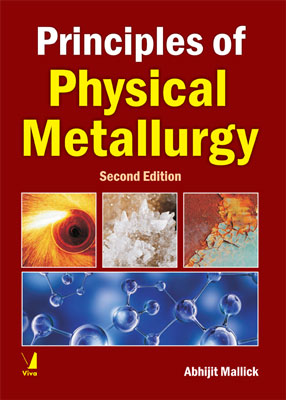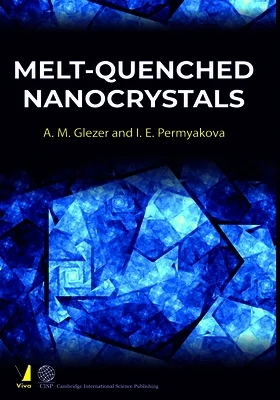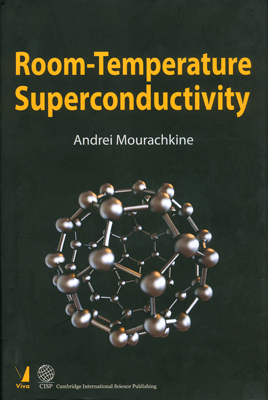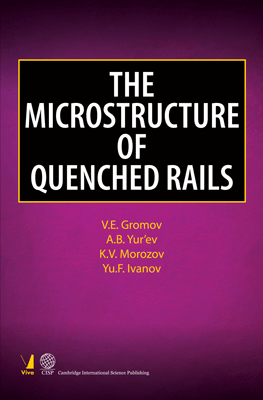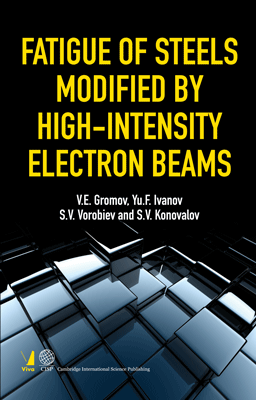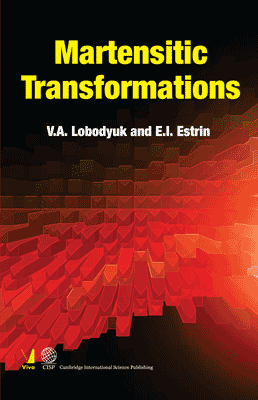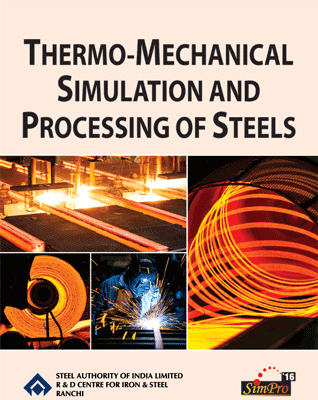Principles of Physical Metallurgy , 2/e
Principles of Physical Metallurgy , 2/e
₹625.50 ₹695.00 Save: ₹69.50 (10%)
Go to cartISBN: 9788130929194
Bind: Paperback
Year: 2015
Pages: 576
Size: 165 x 241 mm
Publisher: Viva Books Originals
Sales Territory: Worldwide
Description:
This book is specially designed for the mechanical and production streams of B.E./B. Tech students. It is also a handy reference textbook for those interested in metallurgy. This book focuses on the fundamentals of physical metallurgy including crystal structure and imperfections, phase equilibria, phase transformations and heat treatment. Failure and corrosion properties of materials have been discussed in detail. A detailed discussion of magnetism, conductors and semiconductors is the asset of this book. The book also highlights the optical properties, diffusion, chemical bonding, non-conventional energy resources, ceramics and composites. Appendix I contains a collection of reference tables. Multiple-choice questions, short-answer-type questions, long-answer-type questions and numerical problems are provided in Appendix II of this book as exercise for students.
Target Audience:
This book is specially designed for the mechanical and production streams of B.E./B. Tech students. It is also a handy reference textbook for those interested in metallurgy.
Contents:
Chapter 1: Solid State Chemistry • Crystallography • Unit Cell • Atomic Radius • Effective Number of Atoms • Atomic Packing Factor • Density of a Cubic Crystal • Fundamental Laws of Crystallography • Law of constancy of interfacial angle • Law of rationality of indices • Characteristics of Miller indices • Law of symmetry • Miller Indices and Interplanar Spacing • Interplanar spacing • Miller indices for HCP crystals • Bragg's Law
Chapter 2: Crystal Defects or Imperfections • Point Imperfections • Imperfection • Schottky defect • Frenkel defect • Non-stoichiometric defects • Metal excess defects • Metal deficiency defect • Impurity defects • Line Imperfections • Edge dislocation • Screw dislocation • Surface Imperfections • Driving Force for Extended Dislocation • Strain Hardening and tPN • Peierls - Nabarro stress (tPN) • Critically Resolved Shear Stress • Dislocation Generator: The Frank-Read Source • Cross-Slip • Slip Bands and Invariant Burgers Vector • Deformation or Mechanical Twinning
Chapter 3: Chemical Bonding • Atom and Molecule • Atomic Spectrum • Filling up of Atomic Orbitals by Electrons • Matter Waves and Schr • dinger Wave Equation • Uncertainty Principle from Schr • dinger Wave Equation • Validity of Neil B • • hr's Theory • Concept of Molecular Orbital • Characteristic Features of MO Theory • Characteristic Features of Valence Bond (VB) Theory • Periodic Table • Chemical Bond • Ionic bond • Covalent bond • Coordinate or dative bond • Hydrogen bond • Bond due to intermolecular forces (van der Waals bond) • Metallic bond
Chapter 4: Diffusion • Definition • Fick's First Law • Kirkendall Effect • Fick's Second Law • Applications of Fick's Law • Growth of oxide layers • Carburizing of steel • Mechanisms of Diffusion • Volume Diffusion • Grain boundary Diffusion • Surface Diffusion • Coring • Factors Influencing Diffusion • Temperature • Concentration • Crystal structure • Impurities • Grain size • Interstitial Diffusion • Diffusion Process in Ionic Crystals
Chapter 5: Magnetism • Definitions • Magnetic flux and dipoles • Flux density • Field intensity • Permeability • Intensity of magnetization • Susceptibility • B • • hr magneton • Classification of Magnetic Materials • Diamagnetism • Characteristic features • Theory • Paramagnetism • Characteristic features • Theory • Limitations of Curie's law • Weiss modification • Ferromagnetism • Characteristic features • Origin of ferromagnetism • Electronic theory • Domain wall theory • Magnetostatic energy • Magnetocrystalline anisotropy energy • Magnetostrictive energy • Anti-ferromagnetism • Characteristic features • Classification of Ferromagnetic Materials • Hysteresis loss • Soft magnetic materials • Beneficial Effects of addition of silicon to iron • Adverse Effects of excess addition of silicon to iron • Alloys • Hard magnetic materials • Eddy Current Loss • Iron Loss • Factors Influencing iron loss and permeability • Ferrimagnetism • Characteristic features • Magnetic Glasses • Probable composition • Preparation • Properties
Chapter 6: Superconductors • Superconductors • Characteristic Features of Superconductivity • Transition temperature • Magnetic properties and Meissner Effect • Types of superconductors • Critical current • London equations and penetration depth • Isotopic Effect • Bardeen, Cooper and Schrieffer Theory • Energy Gap and Coherence Length • Fluxoid or Flux Momentum • Josephson Effect • Specific Heat • Thermal Conductivity • High Temperature Superconductors • Applications
Chapter 7: Conductors • Introduction to Free Electron Theory • Postulates of free electron theory • Electrical conductivity • Drift velocity • Mobility • Conductivity • Average velocity • Average drift velocity and relaxation time • Molar specific heat • Thermal conductivity • Drawbacks of free electron theory • The Quantum Concept of Free Electron Theory • Postulates • Fermi energy • Calculation of Fermi energy • Mean energy • Fermi velocity • Fermi mean free path • Fermi temperature • Carrier concentration at temperature other than K • Contribution of electrons to the Specific heat of metals • Merits and limitations of Sommerfeld theory • Band Theory of Solids • Potential well and potential barrier • Characteristic features • Brillouin zones • Conclusions • Variation of Electrical Resistivity Under Mechanical Stress • Characteristics of an Ideal Conductor • High Resistivity Materials • Thermistors • Mattheson's Rule • Fuse • Introduction • Fuse materials • Types of fuses • Fusing characteristics • Carbon Brushes • Introduction • Preparation of carbon brushes • Types of carbon brushes • Properties of graphite brushes • Applications of carbon brushes • Electrical Contact Materials • Introduction • Classification
Chapter 8: Semiconductors • Introduction • Semiconductor elements • Conduction Mechanism in an Intrinsic Semiconductor • Drift velocity • Mobility • Law of mass action • Carrier Concentration in Valence Band and Conduction Band • Electron concentration in the conduction band • Positive hole concentration in the valence band • Conduction Mechanism in an Extrinsic Semiconductor • Charge Neutrality Equation • Density of Electrons in the Conduction Band of an n-type Semiconductor • Density of Holes in the Valence Band of a p-type Semiconductor • Effect of Temperature on Conductivity of an Intrinsic Semiconductor • Variation of Conductivity with Temperature in an Extrinsic Semiconductor • Characteristic Features of an Intrinsic Semiconductor • Band Gap in Semiconductors • Compound Semiconductors • Hall Effect
Chapter 9: Dielectrics • Introduction • Gauss • theorem • Flux density • Parallel Plate Condenser • Polarization Vector • Polarizability • Types of Polarization • Electronic polarization • Molecular or ionic polarization • Orientation polarization • Space charge polarization • Clasius - Mosotti Relation • Effect of Frequency on Polarization • Dielectric Loss • Dielectric Strength • Intrinsic breakdown • Thermal breakdown • Discharge breakdown • Electrochemical breakdown • Defects breakdown • Active Dielectrics • Ferroelectrics • Anti-ferroelectrics • Piezoelectrics • Pyroelectrics • Insulators • Solid insulators • Liquid insulators • Gaseous insulators • Resistivity of an insulator • Insulation resistance
Chapter 10: Phase Equilibrium • Phase Rule • Single Component System • Water system • Carbon-di-oxide system • Two Component Liquid - Vapor System • Homogeneous mixture • Azeotropic mixture • Binary Phase Diagram for Solid Solutions • Solid solution • Completely miscible solid solutions • Metals miscible in liquid phase but immiscible in solid phase • Metals miscible in liquid phase but only partially miscible in solid phase • Binary solid solutions having peritectic point • Compound forming alloys • Other eutectic systems • Aluminium - silica system • Lead - magnesium system • Solid State Reactions • Precipitation reaction • Ternary Systems • Iron - Carbon Diagram • Allotropy • Composition of Fe/C alloy • Ferrite solubility curve • Cementite solubility curve • Eutectoid mixture and pearlite • Ledeburite • Hypoeutectoid steel • Hypereutectoid steel • Heating and cooling of steel • Change in grain size during cooling/heating • Critical temperature diagram • Effect of impurities on Fe/C alloy • Iron - carbon alloys • Ingot iron • Wrought iron • Steels • Cast iron
Chapter 11: Phase Transformations • Transformation of Austenite to Pearlite • Nucleation and grain growth • Effect of time and temperature on pearlite transformation • Transformation of Austenite to Bainite • Transformation of Austenite to Martensite • Martensitic transformation reaction • Dimensional change during martensitic reaction • Hardness of martensite • Stabilization • Reversibility of the martensitic transformation • Factors influencing Ms and Mf temperatures in steel • Theoretical and Commercial (Practical) Cooling Transformations • Characteristic features of CCT diagram
Chapter 12: Heat Treatment • Austenitizing • Rapid Cooling or Quenching • Quenching Process • Quenching Media • Water quenching medium • Oil quenching medium • Air quenching medium • Molten salt bath • Polymer quenchants • Residual Stress • Hardenability • Factors Influencing Hardenability • Effect of austenite grain size on hardenability • Influence of alloying elements • Influence of carbon on hardenability • Effect of varying hardening temperature • Defects in Steel Objects • Warping and cracking • Soft skin or soft surface • Soft spots • Shallow hardening of carbon steel • Age Hardening • Hardening without solid state reaction • Hardening through precipitation reaction • Nucleation of precipitates • Theory • Applications • Order hardening • Tempering • Effect of tempering on hardness • Effect of tempering on ductility • Cold tempering or Sub-zero treatment • Benefits of sub-zero treatment of steel • Disadvantage of sub-zero treatment of steel • Applications • Step Quenching • Austempering • Martempering • Equilibrium Heat Treatment • Normalizing • Annealing and Spheroidizing • Other Heat Treatment Processes • Solution heat treatment • Inter-critical annealing • Heat-Treating Furnaces • Liquid heating baths
Chapter 13: Alloys • Alloy Steel • Functions of Alloying Elements • Different Types of Steel • Magnetic steel • High strength low alloy steel • Austenitic stainless steel • Composition • Properties • Semi-austenitic steel • Composition • Ferritic stainless steel • Composition • Martensitic stainless steel • Manganese steel • Tungsten steel • Dual phase steel • High Temperature Alloys • High Speed Steel (HSS) • Properties • Applications • Ni-base alloys • Co-base alloys • Cermets • Brazing Alloys • Heating methods • Composition • Advantages of brazing • Disadvantages • Soldering Alloys • Soldering fluxes • Bearing Alloys • Composition of different bearing alloys • Titanium Alloys • Shape Memory Alloys
Chapter 14: Surface Treatment • Introduction • Methods of Surface Treatment • Plating • Oxidation • Hard facing • Induction flame heating • Advantages of induction flame hardening • Disadvantages of induction flame hardening • Case hardening by carburizing • Gas carburizing process • Post-carburizing heat treatment • Carburizing in furnace • Characteristics of carburizing process • Liquid bath carburizing and hardening • Characteristics of cyaniding process • Pack carburizing • Nitriding • Gas nitriding • Bright nitriding • Pack nitriding • Ion nitriding • Case • Advantages of nitrided case • Disadvantages of nitrided case • Principal reasons for nitriding • Nitridable Steels
Chapter 15: Powder Metallurgy • Metallic Powder • Mechanical method • Atomization process • Vapor condensation process • Oxide reduction process • Chemical precipitation process • Electrolytic deposition process • Characteristics of Metal Powders • Chemical composition • Structure of powder • Flow characteristics • Apparent density/bulk density • Particle size • Compaction of Metal Powders • Hot pressing technique • Cold pressing technique • Processing Techniques • Welding of powders • Molding of metal powder • Sintering • Temperature and time • Stages of sintering • Driving force • Solid phase sintering • Liquid phase sintering • Sintering furnace • Post-Sintering Operations • Shrinkage • Applications • Advantages of Powder Metallurgy • Limitations of Powder Metallurgy
Chapter 16: Recrystallization • Cold Working • Cold Annealing or Process Annealing • Recovery • Primary recrystallization • Recrystallization temperature • Factors influencing recrystallization temperature • Driving force • Grain growth • Factors influencing grain growth • Secondary recrystallization (abnormal grain growth)
Chapter 17: Solidification • Kinetics of Nucleation • Radius of nucleus • Critical radius • Principle of Nucleation • Homogeneous nucleation • Heterogeneous nucleation • Crystal Growth During Casting • Chill zone • Columnar zone • Central zone • Supercooling region • Temperature inversion
Chapter 18: Fracture and Creep • Definition • Classification • Cleavage fracture • Shear fracture • Brittle fracture • Ductile failure • Engineering Stress-Strain and True Stress-Strain • True stress and true strain • Engineering stress and engineering strain • Relationship between true parameters and engineering parameters • Flow curve • Hardness of Metals • Brinell Hardness Number • Vickers Hardness Number • Rockwell Hardness Number • Brittleness • Mechanism of Crack Formation • Zone model • Cottrell's model • Intercrystalline and transcrystalline fractures • Resilience and toughness • Factors Influencing Brittle and Ductile Fractures • Griffith Theory • Characteristic features • Ductile-Brittle Transition Temperature • Factors influencing ductile-brittle transition temperature • Protection of Surface from Crack • Fracture Resistance • Plastic Deformation • Hot working • Consequences of hot working • Creep • Factors influencing creep • Creep-resistant materials • Fatigue Failure • Mechanism of fatigue failure • Characteristic features • Factors Influencing fatigue failure
Chapter 19: Corrosion • Definition • Classification • Chemical or Dry Corrosion • Oxidation corrosion • Corrosion by other gases • Liquid metal corrosion • Electrochemical Corrosion • Characteristic features • Polarization of electrodes • Rusting of iron • Other Forms of Corrosion • Factors Influencing Corrosion • Nature of the metal • Nature of the corroding environment • Measures to Prevent Corrosion • Modification of the environment • Modification of the composition of the alloy • Cathodic protection • Inhibitors • Use of protective coatings • Metal coatings • Inorganic coatings • Organic coatings • Some Facts Explained
Chapter 20: Optical Properties • Luminescence • Photoluminescence • Cathode Ray Tube • Television/computer monitor • Oscilloscope tubes • Light Emitting Diode • Luminous efficiency • Failure of LED • Flashing LED • Advantages of an LED • Disadvantages of an LED • Applications • Liquid Crystal Display (LCD) • Smectic phase • Nematic phase • Cholesteric phase • Principle of LCD display • Advantages of an LCD • Disadvantages of an LCD • Laser • Principle of laser action • Applications
Chapter 21: Non-Conventional Resources • Magneto Hydro Dynamic Power Generator • Principle • MHD systems • Open cycle MHD system • Closed cycle MHD system • Advantages of liquid metal system • Limitations of liquid metal system • MHD circuit and power equation • Advantages of an MHD power generator • Thermoelectrical Power Converter • Thermionic Converter • Limitations • Fuel Cell • Working principle • Types of fuel cells • Acid and alkaline fuel cell • Molten carbonate fuel cell • Direct methanol fuel cell • Solid oxide fuel cell (SOFC) • Proton exchange membrane fuel cell (PEMFC) • Zinc-air fuel cell • Regenerative fuel cell • EMF of a fuel cell • Choice of fuel • Advantages of fuel cells • Limitations of fuel cells • Applications of fuel cells • Solar Cell • Photodiode • Photovoltaic cell or solar cell • Theory • Types of solar cells • Advantages of solar cells • Limitations of solar cells • Uses of solar cells
Chapter 22: Composites and Ceramics • Composites • Definition and characteristics • Classification of composites • Advantages and disadvantages of composites • Advantages • Disadvantages • Mechanical properties • Advanced Composite Materials (ACM) • Applications • Preparation • Limitations • Solved problems • Ceramics • Definition and characteristics • Classification • On the basis of application • On the basis of crystal structure • On the basis of chemical composition • Properties • Advantages • Disadvantages • Applications • Refractory Materials • Definition of refractories • Classification of refractory materials • Chemical composition of refractories • Applications • Role of refractory • Refractory requirements • Some properties of refractory materials • Appendix I • Appendix II • Periodic Table and Chemical Symbols • Bibliography • Index
About the Author:
Abhijit Mallick is an Associate Professor in the Department of Chemistry , Academy of Technology, affiliated to West Bengal University of Technology. He completed his B.Sc. Chemistry Honours from Ramakrishna Mission Vivekananda Centenary College, affiliated to Calcutta University and obtained his postgraduate degree from University College of Science and Technology, Calcutta University. He earned his Ph.D. from Indian lnstitute of Technology, Kharagpur. He has published several international papers and three textbooks entitled Chemistry for Engineers, Principles of Physical Metallurgy, Environmental Science and Management. He is a member of the lnstitute of Engineers (India). His areas of interest include applied chemistry, materials science, environmental pollution control and management.
